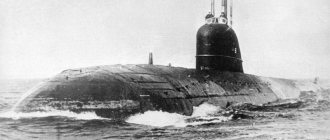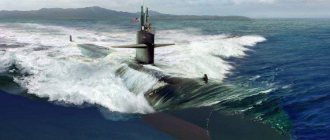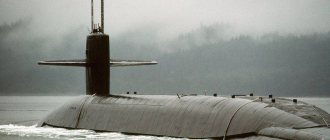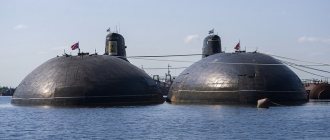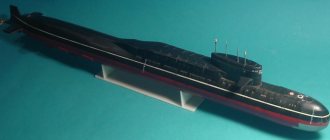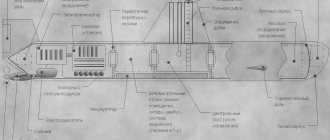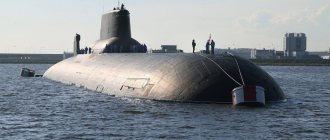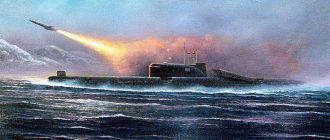Created in the 70s of the last century, Barracuda submarines have a unique hull design that has remained inimitable for 45 years. The experience gained during the development and operation of ships is widely used on modern Russian submarines.
Improved calculation methods and the use of new steel grades have already allowed the new ships to exceed the strength parameters of the titanium hulls of Project 945 Barracuda submarines. The old boats, after the planned modernization, will remain in service, presumably until the mid-2020s.
History of creation
When creating the second generation of Soviet submarines with a nuclear power plant, the Navaga, Murena, Kalmar and Dolphin submarine projects, search work was carried out in parallel on the next third generation of boats.
This was due to the vigorous development of the American nuclear submarine fleet, which began in the 60s, which was considered the main potential enemy. The key difference between the third generation boats was the expanded target detection capabilities.
The technical requirements were formalized in the spring of 1972 in the form of a task for the development of a new boat under the designation “Project 945 Barracuda nuclear submarine.”
The lead developer of the project was Nikolai Kvasha, and the observer from the fleet was Igor Bogachenko.
The development was based on preliminary designs of boats created during the 60s at the Gorky design bureau "Lazurit" (TsKB-112). The designers were faced with restrictions on the size and displacement of the warship, dictated by plans for construction at factories located in the interior of the country.
A key design feature of the Project 945 submarine was the widespread use of titanium-based materials in the manufacture of hull elements. Due to its high strength, it was possible to increase the maximum permissible diving depth by 50% (compared to previous boats with steel hulls).
The use of titanium made it possible to reduce the ship's displacement and the intensity of magnetic fields, which reduced the risk of detection by the enemy.
But precisely because of the expensive hull and technological difficulties in its manufacture, the Barracuda project boats were built in two copies - K-239 "Karp" and K-276 "Crab".
The reduced weight and dimensions of the structure made it possible to begin production of the Barracuda ships at production facilities (Gorky, now Nizhny Novgorod).
In the early 70s, this company was the only one capable of producing a titanium case. Delivery to the base was carried out via inland waterways (along river and canal systems).
Advantages and disadvantages
The main advantage of both the Barracuda and the Condor is their stealth. It was achieved primarily by reducing the noise level created by the submarine's mechanisms. In addition, “demagnetization” provided by the use of titanium alloys is of great importance. The composition of the weapons complex is also quite good, especially on Project 945A boats.
The dynamic characteristics are excellent and do not cause any complaints. The main disadvantage of both projects is the very high cost of manufacturing a titanium case. It is this factor that made the Shchuka-B nuclear submarines, which are very close in design to the Barracudas, much more numerous - after all, they are made of relatively cheap steel.
Project 945 nuclear submarine Kostroma at its last berth
In addition, the on-board electronic equipment of Project 945 and 945A boats today looks outdated. It should have been replaced at the beginning of the 2000s, but now the prospects for further modernization look rather vague, if not completely hopeless.
Author of the article:
Fedorov Dmitry
Design
Along its entire length, the hull of the Barracuda boat is double-hulled. The hydrodynamically perfect outer lightweight hull forms an ellipsoidal bow and an elongated spindle-shaped stern.
Under the light shell is the main body, which has a cylindrical central part, to which conical elements are connected at the bow and stern.
Between the ship's hulls there are two tanks to accommodate the main ballast, equipped with scupper valves and kingstons.
In the event of emergency situations, the tanks are purged with gases generated during the combustion of pyrotechnic charges. The ballast tanks are attached to the outer surface of the robust hull, which avoids deformation and bending that are inevitable when located at great depths.
Inside, the robust hull is divided into six compartments, between which waterproof bulkheads are installed. In one of the compartments of the Barracuda there is a rescue capsule designed to accommodate the entire crew of the boat (59...61 people according to the staff). The capsule, after being separated from the submarine, floats to the water surface on its own.
The main element of the power plant of Project 945 Barracuda ships is the OK-650A model reactor, which uses water as a coolant and reaction moderator.
Uranium dioxide with a high percentage of isotope 235 is used as fuel. The thermal power of the installation is 180...190 MW. The reactor is equipped with four steam generator units and duplicated circulation pumps in the cooling circuits.
The combined operation of the devices ensured reliable cooling of the reactor facility.
Steam generators supply steam to a turbo-gear unit with a power of up to 43 thousand hp, which rotates the main multi-blade propeller of the boat. The use of a screw of this design made it possible to reduce the number of revolutions and reduce the level of hydroacoustic noise.
The ship has two additional small-diameter propellers designed for low-speed movement. The propellers are driven by separate electric motors with a maximum power of up to 370 kW.
The low speed system is used to perform underwater maneuvers at speeds of up to 5 knots, and also as an emergency surface movement system. The engines and propellers are housed in retractable fairings and are kept outside the Barracuda's lightweight hull only when in use.
In addition, the Barracuda boats are equipped with two alternating current generators driven by separate steam turbines. In the event of an emergency, electricity is supplied on board by two diesel generator sets with diesel engines of the DG-350 type (750 horsepower each).
DGSs are capable of generating both direct current for electric motors of retractable propellers, and alternating current to provide electricity to boat equipment.
The reserve of fuel placed on board the ship allows the operation of these generators for 10 days.
The generators charge the batteries, which are placed in two groups in the so-called battery pits. The alternating current required to power the boat's electronic equipment is generated by inverter converters.
The Barracuda series nuclear submarines were equipped with a hydroacoustic complex model MGK-503, equipped with an analog data processing system. Improved characteristics of the complex and a decrease in the hydroacoustic parameters of the boat’s mechanisms made it possible to double the target search radius (compared to boats of previous generations).
In addition, the number of errors when calculating the ship’s coordinates was reduced, which made it possible to rise to the surface less often to clarify the location.
For communications on the Barracuda ships, the Molniya-M complex was used, which supported a communication system via satellites using a towed Paravan-type antenna. The use of a modernized communications complex has improved the range of reception and transmission of signals, as well as their discernibility.
Nuclear torpedo and multipurpose submarines. Projects 945 “Barracuda” and 945A “Condor”
In parallel with the development of second-generation multi-purpose nuclear submarines, the country's leading design bureaus, naval and industry research centers conducted search work on third-generation submarines. For example, in the early 1960s, the Gorky (today Nizhny Novgorod) TsKB-112 “Lazurit” developed a preliminary design design No. 673 - a multi-purpose nuclear submarine, the design of which included many advanced solutions - optimal contours from the point of view of hydrodynamics (without conning fencing), a one-and-a-half-vessel circuit, a single-shaft power plant with one reactor, and the like. Later, work on new multi-purpose nuclear submarines in Gorky continued. One such study was taken in 1971 as the basis for the design of the first Soviet nuclear submarine of the third generation.
B-239 “Karp”, photo from a Norwegian plane on November 1, 1984
Expanding the combat capabilities of the US fleet - primarily the underwater component, which developed most dynamically in the 1960s-80s - required a sharp increase in the anti-submarine potential of the Soviet navy. In 1973, the USSR developed the concept of anti-submarine defense as part of the Argus program. Within the framework of this concept, the CNPO "Kometa" (headed by General Designer Savin) began to implement the program for creating the KSPO "Neptune" (an integrated system for lighting the situation) which included: - the central link of the system was the center for collecting, processing, distributing and displaying information, reflection; — a stationary underwater lighting system that worked across various physical fields of the submarine; — hydroacoustic buoys that are deployed in the oceans by airplanes and ships; — space systems for detecting submarines using various unmasking features; - maneuver forces, which include aircraft, submarines and surface ships. At the same time, multi-purpose nuclear submarines of the new generation, which had enhanced search capabilities, were considered as the most important means of detecting, tracking and destroying (after receiving the appropriate command) enemy submarines.
TTZ for the development of a large multi-purpose nuclear submarine was issued in March 1972. At the same time, the Navy set the task of limiting the displacement of boats within the limits that ensure the construction of submarines at domestic factories (in particular, in the city of Gorky). The main purpose of the new Project 945 submarines (Barracuda) was to track missile carrier strike groups and submarines of a potential enemy, as well as to destroy these targets in the event of hostilities. The chief designer of the project is N.I. Kvasha, and the main observer from the naval forces is I.P. Bogachenko.
A fundamentally important element of the new nuclear submarine was the use in its durable hull of a titanium alloy having a yield strength of 70-72 kgf/mm2, which ensured an increase in the maximum immersion depth by 1.5 times compared to second-generation submarines. The use of a titanium alloy with high specific strength made it possible, by reducing the weight of the hull, to save up to 30% on the displacement of the submarine, which made it possible to build nuclear submarines in Gorky and transport them by inland waterways. In addition, the titanium hull made it possible to significantly reduce the ship’s magnetic field (in this parameter, Project 945 submarines remain leaders among submarines today).
However, the use of titanium entailed a significant increase in the cost of a nuclear submarine and in technical terms. reasons limited the number of ships under construction, as well as the number of enterprises participating in the program (in Komsomolsk-on-Amur, the technology for constructing titanium hulls had not been mastered).
The torpedo-missile system of the new submarine, compared to nuclear submarines of the previous generation, was supposed to have twice as much ammunition, increased firing range, due to the use of an improved target designation system and new ammunition (for missile-torpedoes - 3 times, for torpedoes - 1, 5 times), as well as increased combat readiness (preparing to fire the first salvo required half the time).
In the OKB of the Ministry of Aviation Industry "Novator" under the leadership of L.V. Lyulev in December 1969 began work on new 533-mm second-generation Vodopad and 650-mm Veter anti-submarine missile systems, intended mainly to equip promising third-generation nuclear submarines. “Waterfall”, unlike the Vyuga-53 anti-aircraft missile system, was supposed to be equipped not only with a special warhead, but also with a small-sized homing torpedo UMGT-1 (developed at NPO Uran) with a response range of 1500 m along the acoustic channel, a range of up to 8000 m and a maximum underwater speed of 41 knots. The use of two types of equipment expanded the range of weapon use. The Vodopad, compared to the Vyuga-53, had an increased maximum missile launch depth, which was up to 150 meters, and an increased range of fire ranges (from depths of 20 to 50 meters - from 5 to 50 thousand m, from 150 meters - from 5 to 35 thousand m), the pre-launch preparation time was significantly reduced (which was 10 seconds).
Nuclear submarine K-276 (production number 302, from 06/03/1992 - B-276, from 04/06/1993 - "Crab", from 11/15/1996 - "Kostroma") of project 945 "Barracuda"
“Wind,” which had twice the maximum range compared to “Waterfall,” could be equipped with an UMGT torpedo or a nuclear warhead. The “Waterfall” complex (index RPK-6) entered service with the Navy in 1981 (it was equipped with both nuclear submarines and surface ships), the “Wind” (index RPK-7) - in 1984.
Another type of weapon that was introduced on third-generation nuclear submarines was the homing, remote-controlled torpedo TEST-71. This torpedo was intended to destroy submarines and was equipped with an active-passive homing sonar, which, together with a remote control system, provided two-plane guidance to the target. The presence of a telecontrol system made it possible to monitor the operation of the homing equipment and maneuvering of the torpedo, as well as control them when fired. The operator on board a nuclear submarine, depending on the tactical situation, could redirect the torpedo or inhibit its homing.
The electric power plant ensured the movement of the torpedo in two modes - search (speed 24 knots) and rendezvous mode (speed 40 knots) with multiple mode switching. The maximum range (depending on the prevailing speed) ranged from 15 to 20 thousand meters. The depth of search/target engagement was from 2 to 400 meters. In terms of stealth level, TEST-71 was in many ways superior to the American Mk.48 torpedo, equipped with a piston engine, although the American torpedo, with a comparable range, had a slightly higher speed (about 50 knots).
Nuclear submarine K-276 (plant No. 302, from 06/03/1992 - B-276, from 04/06/1993 - "Crab", from 11/15/1996 - "Kostroma"), after a collision on February 11, 1992 with the nuclear submarine " Baton Rouge "Los Angeles" class. The photo was taken while escorting the boat to the base from the rescue tug SB-523, who was on duty on it as part of the rescue squad of the Northern Fleet
Combat damage to the fencing of the retractable devices of the nuclear submarine K-276 (from 06/03/1992 - B-276, from 04/06/1993 - "Crab", from 11/15/1996 - "Kostroma") of Project 945 "Barracuda" after a collision on 02/11/1992 . with the US Navy nuclear submarine Baton Rouge
To illuminate the surface and underwater situation and target designation, it was decided to use the improved SAC MGK-503 "Scat". Thanks to measures to reduce the noise of a nuclear submarine and reduce its own interference during operation of the sonar system, the target detection range has more than doubled compared to second-generation submarines.
The use of a new electronic weapons system made it possible to reduce the maximum error in determining the location by five times, as well as significantly increase the intervals between ascents when determining coordinates. The communication range has doubled, and the depth of radio signal reception has tripled.
To test the technology and strength issues, a full-scale compartment was built from a titanium alloy, as well as a semi-natural compartment using another, more durable titanium alloy, which was intended for use on ultra-deep-sea promising nuclear submarines. The compartments were delivered to Severodvinsk, where fatigue and static tests were carried out in a special docking chamber.
The Project 945 nuclear submarine was intended to combat enemy missile submarines and surface vessels from strike groups and aircraft carrier formations. The combat potential was increased due to the strengthening of torpedo and missile-torpedo weapons, progress in the development of target designation, detection, navigation, communications systems, the introduction of information and control systems and improvement of tactical and technical elements - immersion depth, speed, stealth, maneuverability, survivability and reliability.
Nuclear submarine "Kostroma", September 23, 2007
The submarine of Project 945 was made according to a double-hull design. The light hull has an ellipsoidal bow and a spindle-shaped stern end. The outboard openings are closed using scupper valves, as well as seacocks on the main ballast tanks.
The durable body, made of titanium alloy, has relatively simple shapes - conical ends and a cylindrical middle part. The end bulkheads are spherical. Durable tanks are attached to the hull in such a way that bending stresses that arise when the submarine is compressed at depth are eliminated.
The submarine's hull is divided into 6 waterproof compartments. The boat is equipped with an emergency blowing system for the main ballast tanks using fuel combustion products.
The boat's crew consists of 31 officers and 28 midshipmen, for whom good living conditions were created. The nuclear submarine has a pop-up rescue chamber that can accommodate the entire crew of the submarine.
Main power plant with a rated capacity of 43 thousand liters. With. includes a water-water reactor OK-650A (power 180 MW) and a steam-gear unit. OK-650A has 4 steam generators, 2 circulation pumps of the first and fourth circuits and 3 pumps of the third circuit.
The boat has two AC turbo generators, two feed pumps and two condenser pumps. To serve consumers who use direct current, there are two reversible converters and two groups of batteries.
The multi-bladed propeller has improved hydroacoustic characteristics and a reduced rotation speed.
On the left is the large nuclear submarine "Pskov" of project 945A "Condor", on the right is the nuclear submarine "Kostroma" of project 945 "Barracuda". The main visual difference is the shape of the bow of the retractable device fence and the conning tower
If the main power plant fails, emergency power sources, as well as backup means of propulsion, were provided for subsequent commissioning. There are a pair of diesel generators DG-300 equipped with reversible converters (each 750 hp) with a ten-day fuel reserve. They were intended to generate alternating current for general ship consumers and direct current for propulsion electric motors.
To ensure submerged movement at speeds of up to 5 knots, the nuclear submarine was equipped with two DC propulsion motors (each with a power of 370 kW), each driving its own propeller.
The submarine is equipped with the MGK-503 Skat-KS sonar system (has analog information processing). The Molniya-M complex consists of a satellite communications system and a towed Paravan antenna.
The complex of missile and torpedo weapons and the combat information and control system provide single and salvo firing without depth restrictions (up to the maximum diving depth). Four torpedo tubes with a caliber of 533 millimeters and two of 650 millimeters are mounted in the bow. The ammunition load includes 40 weapons - torpedoes and missile-torpedoes.
The lead boat of Project 945, K-239 “Karp,” was laid down on May 8, 1982 in Sormovo, launched on July 29, 1983, and entered into service on September 21, 1984. The second vessel of the same type, K-276 "Crab", was laid down in August 1983 and launched in April 1984. The nuclear submarine entered service with the Navy in the fall of 1987. In 1996, K-276 (under the command of Captain First Rank V. Sokolov) was given the name “Kostroma”.
A further development of the Project 945 submarine was the Project 945A nuclear submarine (“Condor”). The main difference between the submarine and the ships of the previous series is the changed composition of the armament, which included six torpedo tubes of 533 mm caliber. The ammunition included the Granat strategic cruise missiles, intended to destroy ground targets at a range of up to 3 thousand meters. The submarine was also equipped with eight Igla MANPADS self-defense kits.
Projections of the Project 945A Condor nuclear submarine
The number of waterproof compartments has increased to seven. The submarine received an improved power plant with a capacity of 48 thousand hp. with a 190-megawatt OK-650B reactor. Two thrusters (370 hp each) were installed in the retractable columns. In terms of the level of unmasking features (magnetic field and noise), the Project 945A submarine was the most stealth submarine in the domestic fleet.
The first improved submarine, K-534 Zubatka, was laid down in June 1986 in Sormovo, launched in July 1988 and entered service on December 28, 1990. “Zubatka” was renamed “Nizhny Novgorod” in 1995 (captain of the first rank Voronkov). This was followed by the “Perch” K-336 (laid down in May 1990, launched in June 1992 and put into operation in 1993). This nuclear submarine was renamed Pskov in 1995.
The fifth nuclear submarine, built according to Project 945B (“Mars”), which in its characteristics practically met the requirements for fourth-generation submarines, was cut up in 1993 on a slipway.
Nuclear submarine "Pskov". Ara-Guba. Summer 2004. The starboard side with traces of soot after a fire during repairs in the floating dock PD-50 of the 82nd Shipyard
Near the island of Kildin, in Russian territorial waters, on February 11, 1992, K-276, under the command of captain of the second rank I. Loktya, collided with the American nuclear submarine Baton Rouge (Los Angeles), which was trying to secretly monitor Russian Navy ships in the training area. As a result of the collision, the Crab's wheelhouse, which had ice reinforcements, was damaged. The situation of the American nuclear submarine turned out to be more difficult; it barely managed to reach the base, after which they decided not to repair the boat, but to remove it from the fleet.
Currently, all large nuclear submarines of projects 945 and 945A continue to serve as part of the first flotilla of submarines in the Northern Fleet (Ara Guba), except for the B-239 Karp, which was withdrawn from service in 1998.
Main technical characteristics of nuclear submarines of projects 945 and 945A:
Surface displacement – 6300/6470 t; Underwater displacement – 9100/10400 t; Length – 107.0/110.5 m; Width – 12.2 m; Draft – 8.8/9.4 m; Maximum underwater speed 35 knots; Maximum surface speed 19 knots; Working immersion depth – 480/520 m; Maximum diving depth – 550/600 m; Crew – 60/65 people.
The Kostroma nuclear submarine undergoing repairs in 2006. A rare photo of the Project 945 nuclear submarine propeller
Characteristics and weapons
| Parameter | Meaning |
| Displacement surface/underwater, tons | 5940/9600 |
| Length, m | 107,16 |
| Width, m | 12,28 |
| Average draft, m | 9,62 |
| Surface/underwater speed, knots | 12,1/35,15 |
| Working depth, m | 480 |
| Maximum depth, m | 550 |
| Navigation autonomy, days | 100 |
On the Barracuda boats, six torpedo tubes are installed in the bow, adapted for launching torpedoes or missile-torpedoes:
- two with pipe diameter 650 mm;
- four with a diameter of 533 mm.
The boat's ammunition includes up to 40 torpedoes and missile-torpedoes (12 of them with a caliber of 650 mm) or up to 42 barrage mines. As the main armament, the Barracudas were equipped with an inconspicuous 533 mm electric torpedo of the TEST-71 type, equipped with a homing device.
To aim a torpedo at short distances, manual remote guidance via wires could be used, performed by an operator on board the boat. If necessary, he could reassign targets or turn off the homing mode.
The missile-torpedoes of the PRK-7 “Veter” complex with a caliber of 650 mm had an increased range and could be equipped with a conventional (UGMT-1) or nuclear warhead.
As an air defense system on board the Barracuda-type boats there was an Igla-1 air defense system; the ammunition load was 8 missiles.
Representatives
In total, from 1982 to 1993, 2 nuclear submarines of Project 945A “Condor” were built: B-336 “Okun” (Pskov), K-534 “Zubatka” (Nizhny Novgorod). The submarines are part of the 7th Division of the Northern Fleet, based at Ura Guba (Vidyaevo)[2].
| Name | Head No. | Bookmark | Launching | Commissioning | Status |
| K-534 “Nizhny Novgorod” (“Zubatka”) | 3003 | 15.02.1986 | 08.07.1989 | 26.12.1990 | Included. In service |
| B-336 "Pskov" ("Perch") | 3004 | 29.07.1989 | 28.07.1992 | 14.12.1993 | As part of the SF. In service |
Interesting Facts
The use of titanium in the hull structure significantly reduced the magnetic field from the ship. The field performance of the Project 945 Barracuda nuclear submarine remained unsurpassed at the beginning of the 2000s, i.e. 30 years after the start of design.
In the winter of 1992, the submarine K-276 collided with the American nuclear submarine Baton Rouge (Los Angeles class). As a result of the contact on K-276, the upper part of the cabin, equipped with amplifiers for floating in ice, was partially destroyed.
The American ship remained afloat, but received significant damage and was not put back into service.
The crew of K-276 subsequently painted a star on the wheelhouse with the number 1 located inside. A similar practice of marking victories was common on Soviet submarines during the Great Patriotic War.
Afloat: will the Russian fleet receive nuclear submarines
What changes have the new state Navy armament program undergone?
According to TASS, during the Army-2019 forum, which opened in Kubinka near Moscow, it is planned to sign a contract for the construction of four more nuclear submarines for the Russian Navy as part of the state arms program for 2018–2027. The ordered submarines will include two “strategists” - Project 955A Borei-A missile-carrying submarines - and two Project 885M Yasen-M multi-purpose cruise missile submarines. Their construction should begin in the coming years, but delivery of these ships to the fleet is expected after 2027. Izvestia looked into the consequences of this contract.
Impact on history
The Barracuda series boats served as the basis for the creation of the next generations of submarines, equipped with modernized nuclear power plants, improved weapons (including not only torpedoes, but also missiles), as well as improved underwater control systems.
On the basis of Project 945, boats of the 945A Condor type were created, armed with strategic cruise missiles of the Granat type, as well as Igla anti-aircraft missile systems.
A further development of the Barracuda project was to be the Mars boat, which would be a fourth-generation nuclear submarine. Due to the collapse of the USSR and a sharp reduction in funding, construction of the ship was stopped, and the constructed units were dismantled for metal.
The first ship of the Karp series was placed in long-term storage at the base in Severomorsk in 1998, but before that they managed to assign it a new name, Tula. In 2013, the ship was transferred to Severodvinsk for repairs and modernization.
In 2015, work was suspended due to insufficient funding. To date, work has resumed, but the completion date is not known.
The second K-276 boat, currently designated B-276 “Kostroma,” must undergo repairs and modernization at the shipyards in Severodvinsk.
It is planned to replace electrical equipment, fuel assemblies, and install missile weapons. An agreement to modernize the ships of the Barracuda series (projects 945 and 945A) was concluded back in 2014, but to date work has not begun.
Use in exercises and combat duty
Unfortunately, there is very little information about the use of Project 945 submarines in the Soviet naval forces. It is only known that the lead ship of this series, the K-239 “Karp,” from the moment it entered combat service (which happened on September 21, 1984), was operated in intensive mode over the next four and a half years. This additional test made it possible to confirm all the declared characteristics of the submarine.
The new boat appeared on the pages of Western media even before it was put into service, in the summer of 1984, when the K-239 was somehow photographed. American experts rated the Soviet submarine very highly, although they did not yet have reliable information about it.
One of the first foreign photographs of the Karp nuclear submarine. Taken on November 1, 1984 from a Norwegian reconnaissance aircraft
Subsequently, speaking about the experience of operating the Barracuda, Vice Admiral M.V. Motsak, who served as chief of staff of the Northern Fleet in 2000, noted that the equipment of these submarines made it possible to confidently establish contact with the enemy and record all his movements. Russian submarines remained unnoticed. Motsak, in particular, said that the K-239 alone in 1995 provided tracking of American submariners for four times longer than all surface ships.
The most famous incident involving a Project 945 submarine occurred in February 1992, during an exercise. While within Russian territorial waters, near the island of Kildin, the submarine K-276 “Crab” (later renamed B-276 “Kostroma”) rammed the American nuclear submarine SSN-689 Baton Rouge. This Los Angeles-class multi-purpose submarine tried to monitor the progress of the maneuvers while remaining undetected.
The result of the collision for the American sailors was quite sad - a fire broke out on the boat, the consequences of which ultimately led to the decommissioning of the warship. The wheelhouse at the "Crab" was damaged, which was restored in the summer of 1992. The assessment of this incident can hardly be unambiguous - the opponents managed not to see each other, which does not speak in anyone’s favor. The “fatal” damage to the American nuclear submarine was thus the result of an accident.
Dismantling the damaged SSN-689 Baton Rouge after its decommissioning
Today, both Project 945 submarines have been withdrawn from the fleet and sent to repair shops. But they are unlikely to be destined to return to service - there is no money for modernization. The same fate, unfortunately, may befall two Project 945A submarines.
